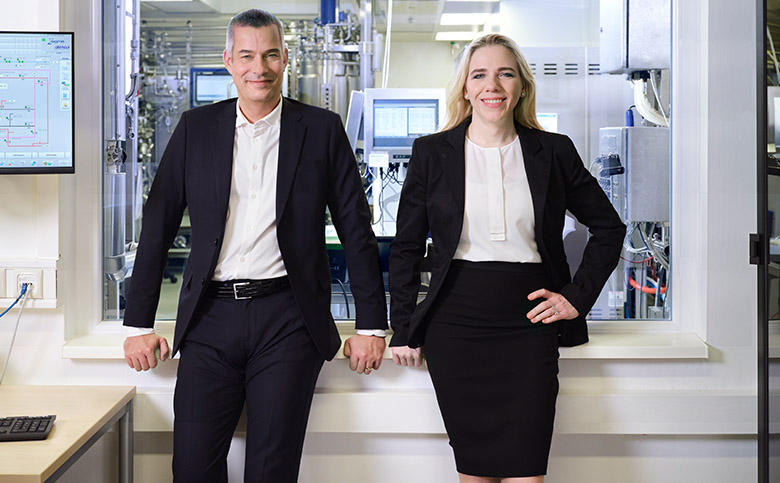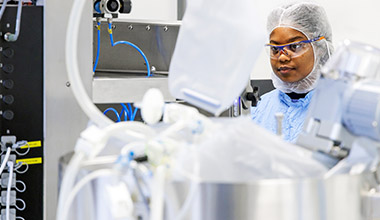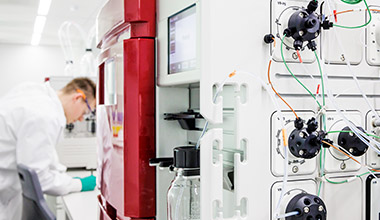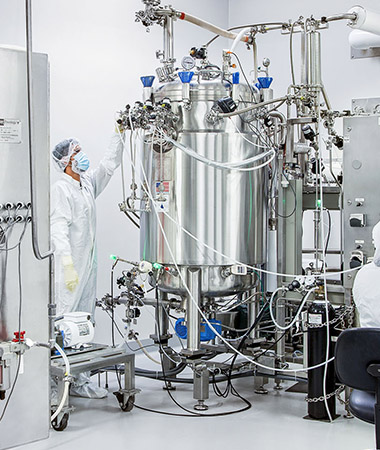Biotechnology
The mRNA Mission
No one can tell which virus will trigger the next pandemic. But one thing’s for sure: the international community needs to be better prepared. The new mRNA competence center in Halle demonstrates WACKER’s active involvement and commitment in this regard – not only when it comes to vaccines: our mRNA technology is paving the way to the medicine of the future.
The year is 2025 and a virus is rapidly spreading around the globe. Sounds like déjà vu? Unfortunately, this kind of scenario is not unlikely. Pathogens from animals can spread to humans, causing infectious – also known as zoonotic – diseases (zoonoses). “Scientists reckon there will be more frequent outbreaks of pandemics in the future. Researchers predict their recurrence in cycles of three to five years,” says Guido Seidel, a Ph.D. chemist and biotechnologist. Together with Melanie Käsmarker, who studied business administration, he is co-managing director at Wacker Biotech, a subsidiary of the Munich-based WACKER chemical group. Like Seidel, Käsmarker has been working in the biotech sector for many years. Both are currently involved in the herculean task of improving preparedness measures to combat future pandemics on the one hand and shaping the medicine of the future on the other:

“We are expanding our Halle site into a competence center for mRNA actives,” says Käsmarker. “The COVID-19 pandemic acted in a way as a catalyst for mRNA technology, an area in which we see very great potential not only in the development of vaccines but also, for example, in developing novel approaches for treating cancer.”
The Best Side Effect of the Coronavirus Pandemic
This technology has given the biopharma industry a powerful boost: “Almost half of all newly approved drugs are now biopharmaceuticals,” says Seidel. “Patient treatment would nowadays be inconceivable without medical biotechnology.” Experts believe that the share of mRNA therapeutics is likely to increase further – which is mainly due to their smart mode of action.
The abbreviation mRNA stands for messenger ribonucleic acid. In our cells, mRNA functions as a molecular messenger that conveys the blueprint for a specific protein from the genome in the nucleus to the relevant ribosomes, also known as the protein factories of the cell. These then produce the required protein. In the case of Corona vaccines, pharmaceutical companies such as Biontech and Moderna use a piece of the mRNA that codes the spike protein of the SARS-CoV-2 virus. This distinguishing feature on the envelope of the pathogen acts as a fingerprint that can easily be identified by our immune system. In the event of an actual infection, our immune system immediately recognizes the virus and can combat the intruder effectively. “However, this mode of action can also be used where proteins in our body are malfunctioning,” says Seidel. “That’s why mRNA therapeutics should also be suitable for autoimmune and cardiovascular diseases and tumors,” he explains. A cancer vaccination, for example, would involve injecting the patient with the blueprint of a protein specific to an individual tumor. This component can be identified by analyzing the genome of the tumor cells. The vaccination would then help the immune system in distinguishing between healthy and diseased cells. That’s when mRNA vaccines could come into the picture and reveal their true potential.
Large-Scale Production of mRNA Actives
What’s more, the COVID-19 pandemic showed that an effective vaccine is only half the story. That’s because suitable production capacity is needed to make large quantities of vaccines available to the public within a short period of time, which is where WACKER’s expertise comes in: “When it became apparent in early 2020 that the mRNA approach was suitable for large-scale vaccine production, we reacted immediately,” recalls Käsmarker. “We quickly got in touch with the relevant pharmaceutical companies and created production capacity at our existing site in Amsterdam.” The WACKER Group focuses all its biopharmaceutical activities within its Wacker Biotech subsidiary. “We learned a lot and gained expertise during this time. We are now benefiting from this as we construct our mRNA competence center in Halle,” explains Käsmarker, who was born and raised there.
“The COVID-19 pandemic was something of a catalyst for mRNA technology.”
Well Prepared for the Next Pandemic
The mRNA project in Halle is not only getting backing from the two committed Wacker Biotech managing directors, but also from the German government: in view of its experience with the initial vaccine shortage during the COVID-19 pandemic, the German government has introduced measures to ensure vaccine production and supply. Pandemic preparedness contracts have been concluded for the production of vaccines. Pharmaceutical companies with the corresponding know-how and capacities were invited to apply. Wacker Biotech and CordenPharma, a company specializing in the production of specific lipids and the filling of pharmaceuticals, applied as joint bidders and were awarded the contract along with four other companies. If needed, Wacker Biotech and CordenPharma will supply Germany with up to 80 million mRNA-based vaccine doses per year starting in 2024.

“It takes not only research-based pharmaceutical companies working on new active ingredients, but also contract manufacturers who have extensive expertise in bioprocess engineering together with the corresponding production capacities,” Seidel explains. This means that Wacker Biotech, as a Contract Development and Manufacturing Organization (CDMO), is commissioned by pharmaceutical companies to produce their active pharmaceutical ingredients for the market and for the purpose of clinical trials. “The rapid successes in vaccine production would hardly have been possible without companies like us, because we can produce the new mRNA actives in larger quantities,” says Seidel.



mRNA – made in Halle
There are several reasons why Wacker Biotech chose Halle as the site for its mRNA competence center, Käsmarker explains: “In order to secure vaccine supply in Germany, the government stipulated that highly critical production steps – which account for most of the production process – would be performed in our country.” At the same time, the city of Halle has many advantages: “We are located in the middle of Central Germany’s Chemical Triangle, and we have close links to Halle University with its focus on science and engineering. We also benefit from our location at Weinberg Campus Technology Park, the innovation hub for the life science industry in the region.” This also helps in attracting qualified personnel: Wacker Biotech plans to hire 200 new employees as part of the expansion.
“The rapid success in vaccine production would hardly have been possible without companies like us.”
In addition to technology platforms and production facilities, success requires above all the expertise and commitment of employees. “In order to make the best use of our global expertise and ensure that it all comes together at our new mRNA competence center, we need to actively involve people. We want them to join us in pursuing these projects and accompany us on our journey – and be proud of what they are doing for humanity,” says Käsmarker, explaining the spirit that Wacker Biotech lives by.
mRNA at the Touch of a Button
All in all, this is a very good basis for the planned record growth in Halle: it will take just two years to build the new mRNA competence center. Four production lines for the manufacture of mRNA biopharmaceuticals are planned. This will more than triple capacity at the site.
When everything is in place in Halle as planned in 2024, the ‘warm facility’ concept will apply. The production facilities will be running, maintained and fully on standby. Staff will be on standby too. “Should we receive an order from the Center for Pandemic Vaccines and Therapeutics to produce mRNA vaccines, we will be able to deliver within just four months,” explains Seidel. The Center for Pandemic Vaccines and Therapeutics (ZEPAI) based at the Paul-Ehrlich-Institut in Langen represents the German government in pandemic matters. “Our capacity in Halle will enable us to produce various active ingredients simultaneously,” adds Käsmarker. WACKER uses about half of this capacity for its own projects, while the other half is reserved as standby capacity for the German government.
Wacker Biotech recognized the potential in mRNA technology early on: “We have been working on nucleic acid technologies since 2018, and we have been specifically expanding this up-and-coming field since 2020,” says Seidel. “Starting with our established biotech sites in Halle and Jena, we then added Amsterdam, a state-of-the-art production facility.” In 2021, Wacker Biotech acquired another site, this time in San Diego. This site has decades of experience in the production of plasmid DNA, or pDNA for short. This ring-shaped DNA is the template for subsequent mRNA active substances and thus the most important raw material. The construction of the mRNA competence center in Halle now brings things full circle.
Setting the Course for Further Growth
And the course for further growth has already been set: in Munich, WACKER is currently investing in the construction of a biotech research center, which is also scheduled to be operational in 2024. Here, WACKER is pooling and intensifying its research in the field of biotechnology. A number of research partnerships in the field of mRNA-based actives have been established. For Seidel and Käsmarker, these are further, very motivating signs.
The fact that Wacker Biotech recognized the potential of biopharmaceuticals and invested in the technology years ago is paying off today with the company playing a leading role. “We’re working on something that helps us all,” Seidel and Käsmarker answer when asked what motivates them most. “Add to that the potential of mRNA technology to cure cancer – one of mankind’s dreams.” We don’t know when that will be but we’re getting closer to fulfilling this dream.
Cyclodextrins for the Perfect Topping
Coffee beverages such as cappuccino and latte macchiato remain extremely popular. What’s more, there’s a constant stream of new lifestyle products such as bubble tea – a drink usually served cold. Originally from Asia, it is gaining ever more fans in other parts of the world. Such beverages usually come with a foamed topping, which has to meet certain requirements. The foam should have a particularly fine consistency and be as voluminous and stable as possible.
This is where WACKER’s alpha-cyclodextrins come in. The sugar molecules permit a higher, stable foam volume, while ensuring a creamy texture. And not only with milk in the traditional sense. The growing demand for vegan food is also turning the spotlight increasingly on to plant-based milk substitutes. Studies from WACKER’s Food Lab prove that cyclodextrins reveal their benefits particularly in plant-based milk alternatives. As they do in cold mixed drinks, which are particularly popular in Asia. Thanks to this WACKER ingredient, substantial foam can be produced that does not require any fats or proteins at all. In addition, the EU Commission has confirmed that the molecules have a health-promoting effect. Consuming alpha-cyclodextrin as part of a starchy meal helps to reduce the postprandial rise in blood sugar levels. By lowering blood sugar, alpha-cyclodextrins reduce the glycemic index (GI) of foods. This is not only important for diabetics. Products are thus digested more slowly, keeping blood sugar levels low at all times. By following an appropriate diet, you can thus reduce the risk of cardiovascular disease, obesity and diabetes.
Cyclodextrins are produced via enzymatic degradation of plant starch in a fermentation process. The molecules owe their effect to their three-dimensional structure. The interior of a ring-shaped sugar molecule is lipophilic (i.e. fat loving), while its exterior is hydrophilic (water loving), allowing it to interact with the food matrix in many different ways. Cyclodextrins not only influence the foaming properties of tea and coffee beverages. They are able to mask undesirable flavorings. They replace egg in sweet baked goods or in mayonnaise, enabling vegan recipes that are proving increasingly popular among consumers. This offers promising growth opportunities for WACKER BIOSOLUTIONS, which is constantly developing new applications for these versatile molecules in its food labs around the world.
WACKER BIOTECHNOLOGY – Strategy and Goals
The Booming Biotech Market
Growth
Sales of 1 billion euros by 2030
Profitability
EBITDA margin > 25 percent ROCE >> cost of capital
Specific investment focus
Capacity expansion in Europe and the USA, innovations, acquisitions
Focus markets
Biopharmaceuticals/drugs for innovative therapies, healthy nutrition/fermentatively manufactured ingredients based on renewable raw materials
Biotechnology is on course for growth. Studies predict that the market will grow annually by around 9 percent worldwide in the coming years. The goals set by WACKER’s life science division are correspondingly ambitious. Around 1 billion euros - that’s how much WACKER BIOSOLUTIONS is expected to generate in terms of sales in 2030. The EBITDA margin is expected to exceed 25 percent by that time. In addition, there are plans to increase profitability: return on capital employed (ROCE) is expected to significantly exceed the cost of capital in 2030. One pillar of the division’s growth strategy is biologics – in particular the field of advanced medicines. This includes, for example, the production of both plasmid DNA and mRNA-based actives. The other pillar is the fermentation-based manufacturing of ingredients for foodstuffs and food supplements based on renewable raw materials. This involves, for example, devising solutions for the production of meat substitutes. The trend toward a healthy diet based on sustainably produced food is a key driver here. To accelerate growth at WACKER BIOSOLUTIONS, investments of more than 80 million euros annually are earmarked for organic growth. Production capacity expansions are planned in the US and Europe, while research is to be intensified. As part of these measures, WACKER is currently investing in the construction of a new biotech research center at its Munich site. This center is scheduled to come on stream in 2024. The division aims to expand its product portfolio through innovation, partnerships and acquisitions. It has set itself the goal of making Life Science business a central pillar of the WACKER Group by 2030.

